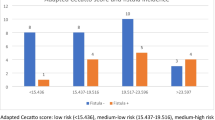Abstract
Pharyngocutaneous fistula is the most common complication (8.7 to 22%) in the immediate postoperative period following total laryngectomy. The study's objective was to determine the incidence of post-laryngectomy fistulas in patients operated on in our department to establish whether specific factors predispose to fistula formation and to determine whether fistulas and tumor recurrence are related. Between 1992 and 2001, 377 cases of laryngeal carcinoma were diagnosed, and the patients underwent total laryngectomy in our department. Of these patients, 291 had total laryngectomy as the primary management of their disease, while in 86 patients the operation treated recurrence of the disease. In 92 patients, total laryngectomy was combined with radical or eclectic neck dissection. The presence of early postoperative fistula was established in 49 of the 377 patients (13%) studied. The cancerous stage, exact localization of the tumor, degree of differentiation, previous irradiation, patient's age, performance or not of neck dissection or emergency tracheostomy and fitting of voice prostheses were all factors that, after statistical analysis, did not appear to significantly influence the incidence of postoperative fistulas. Factors that did show statistical significance were the histological infiltration of the tumor's surgical margins (11% negative vs. 38% with positive margins) and coexisting early complications. Fistula management was conservative in the majority of cases. The necessary closure period for a fistula varied between 5 and 81 days (mean: 29 days). Postoperative follow-up of all patients revealed that fistulas did not influence the incidence of tumor recurrence. The incidence of postoperative fistulas in our study was 13%. Incomplete excision of the tumor and coexisting complications were related, among other things, to a higher rate of fistula formation. The rate of tumor recurrence after total laryngectomy was not related to the presence of a fistula during the postoperative period.




Similar content being viewed by others
References
Andrews JC, Mickel RA, Hanson DG, Monahan GP, Ward PH (1987) Major complications following tracheoesophageal puncture for voice rehabilitation. Laryngoscope 97:562–567
Bradford CR, Wolf GT, Fisher SG, McClatchey KD (1996) Prognostic importance of surgical margins in advanced laryngeal squamous carcinoma. Head Neck 18:11–16
Cavalot AL, Gervasio CF, Nazionale G, Albera R, Bussi M, Staffieri A, Ferrero V, Cortesina G (2000) Pharyngocutaneous fistula as a complication of total laryngectomy: review of the literature and analysis of case records. Otolaryngol Head Neck Surg 123:587–592
Celikkanat S, Koc C, Akyol MU, Ozdem C (1995) Effect of blood transfusion on tumor recurrence and postoperative pharyngocutaneous fistula formation in patients subjected to total laryngectomy. Acta Otolaryngol 115:566–568
Davis RK, Vincent ME, Shaphsay SM, Strong MS (1982) The anatomy and complications of "T" versus vertical closure of the hypopharynx after laryngectomy. Laryngoscope 92:16–22
Fradis M, Podoshin L, Ben David J (1995) Post-laryngectomy pharyngocutaneous fistula—a still unresolved problem. J Laryngol Otol 109:221–224
Friedman M, Venkatesan TK, Yakovlev A, Lim JW, Tanyeri HM, Caldarelli DD (1999) Early detection and treatment of postoperative pharyngocutaneous fistula. Otolaryngol Head Neck Surg 121:378–380
Herranz J, Sarandeses A, Fernandez MF, Barro CV, Vidal JM, Gavilan J (2000) Complications after total laryngectomy in nonradiated laryngeal and hypopharygeal carcinomas. Otolaryngol Head Neck Surg 122:892–898
Hier M, Black MJ, Lafond G (1993) Pharyngo-cutaneous fistulas after total laryngectomy: incidence, etiology and outcome analysis. J Otolaryngol 22:164–166
Ikiz AO, Uka M, Guneri EA, Erdag TK, Sutay S (2000) Pharyngocutaneous fistula and total laryngectomy: possible predisposing factors, with emphasis on pharyngeal myotomy. J Laryngol Otol 114:768–771
Johansen LV, Overgaard J, Elbrond O (1988) Pharyngo-cutaneous fistulae after laryngectomy. Influence of previous radiotherapy and prophylactic metrinidazole. Cancer 61:673–678
Lundgren J, Olofsson J (1979) Pharyngocutaneous fistulae following total laryngectomy. Clin Otolaryngol 4:13–23
Maniglia AJ, Lundy DS, Casiano RC, Swim SC (1989) Speech restoration and complications of primary versus secondary tracheoesophageal puncture following total laryngectomy. Laryngoscope 99:489–491
Markou K, Nikolaou A, Nalbadian M, Petridis D, Nicolaidis V, Daniilidis I (2002) How often is total laryngectomy necessary for the treatment of T1 failures after radiotherapy or cordectomy? Eur Arch Otolaryngol Head Neck Surg 259:4–10
Nikolaou AC, Markou CD, Petridis DG, Daniilidis IC (2000) Second primary neoplasms in patients with laryngeal carcinoma. Laryngoscope 110:58–64
Papazoglou G, Doundoulakis G, Terzakis G, Dokianakis G (1994) Pharyngocutaneous fistula after total laryngectomy: incidence, cause, and treatment. Ann Otol Rhinol Laryngol 103:801–805
Parikh SR, Irish JC, Curran AJ, Gullane PJ, Brown DH, Rotstein LE (1998) Pharyngocutaneous fistulae in laryngectomy patients: the Toronto Hospital experience. J Otolaryngol 27:136–140
Redaelli de Zinis LO, Ferrari L, Tomenzoli D, Premoli G, Parrinello G, Nicolai P (1999) Postlaryngectomy pharyngocutaneous fistula: incidence, predisposing factors, and therapy. Head Neck 21:131–138
Seikaly H, Park P (1995) Gastroesophageal reflux profylaxis decreases the incidence of pharyngocutaneous fistula after total laryngectomy. Laryngoscope 105:1220–1222
Shemen LJ, Spiro RH (1986) Complications following laryngectomy. Head Neck Surg 8:185–191
Soylu L, Kiroglu M, Aydogan B, Cetik F, Kiroglu F, Akcali C, Ozsahinoglu C (1998) Pharyngocutaneous fistula following laryngectomy. Head Neck 20:22–25
Thawley SE (1981) Complications of combined radiation therapy and surgery for carcinoma of the larynx and inferior hypopharynx. Laryngoscope 91:677–700.
Tomkinson A, Shone GR, Dingle A, Roblin DG, Quine S (1996) Pharyngocutaneous fistula following total laryngectomy and postoperative vomiting. Clin Otolaryngol 21:369–370
Virtaniemi JA, Kumpulainen EJ, Hirvikoski PP, Johansson RT, Kosma VM (2001) The incidence and etiology of postlaryngectomy pharyngocutaneous fistulae. Head Neck 23:29–33
Weingrad DN, Spiro RH (1983) Complications after laryngectomy. Am J Surg 146:517–520
Author information
Authors and Affiliations
Corresponding author
Rights and permissions
About this article
Cite this article
Markou, K.D., Vlachtsis, K.C., Nikolaou, A.C. et al. Incidence and predisposing factors of pharyngocutaneous fistula formation after total laryngectomy. Is there a relationship with tumor recurrence?. Eur Arch Otorhinolaryngol 261, 61–67 (2004). https://doi.org/10.1007/s00405-003-0643-6
Received:
Accepted:
Published:
Issue Date:
DOI: https://doi.org/10.1007/s00405-003-0643-6




